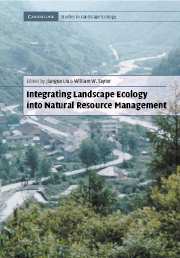Book contents
- Frontmatter
- Contents
- List of contributors
- Foreword
- Preface
- Acknowledgments
- PART I Introduction and concepts
- PART II Landscape structure and multi-scale management
- PART III Landscape function and cross-boundary management
- 7 Assessing the ecological consequences of forest policies in a multi-ownership province in Oregon
- 8 Incorporating the effects of habitat edges into landscape models: Effective area models for cross-boundary management
- 9 Aquatic-terrestrial linkages and implications for landscape management
- PART IV Landscape change and adaptive management
- PART V Landscape integrity and integrated management
- PART VI Syntheses and perspectives
- Index
- Plate Section
7 - Assessing the ecological consequences of forest policies in a multi-ownership province in Oregon
Published online by Cambridge University Press: 14 January 2010
- Frontmatter
- Contents
- List of contributors
- Foreword
- Preface
- Acknowledgments
- PART I Introduction and concepts
- PART II Landscape structure and multi-scale management
- PART III Landscape function and cross-boundary management
- 7 Assessing the ecological consequences of forest policies in a multi-ownership province in Oregon
- 8 Incorporating the effects of habitat edges into landscape models: Effective area models for cross-boundary management
- 9 Aquatic-terrestrial linkages and implications for landscape management
- PART IV Landscape change and adaptive management
- PART V Landscape integrity and integrated management
- PART VI Syntheses and perspectives
- Index
- Plate Section
Summary
Introduction
Advances in landscape ecology, ecosystem management, geographic information systems, and remote sensing have led us from the stand, to the landscape, and to broader scales in natural resources planning and management. As science and management have expanded to these scales, they frequently encompass multi-ownership landscapes. The management and scientific challenges posed by multi-ownership landscapes are especially complex. Species and ecosystems do not recognize legal boundaries between ownerships (Forman, 1995; Landres et al., 1998), and the landscape dynamics of individual ownerships is controlled by a complex of economic, social, political, and biophysical forces. The aggregate ecological conditions of landscapes are controlled by the spatial pattern and dynamics of individual owners and ecological interactions among those ownerships. Solutions to problems of conservation policy and practices for multi-ownership landscapes do not lie in isolated owner-by-owner planning and management. Broader scale approaches are needed. Work in multi-ownership landscapes also reveals the need for increased integration among ecological and social sciences. In most contemporary landscapes, the dominant disturbance regimes are directly or indirectly controlled by human activities. In this chapter we will present a case study to demonstrate the importance of taking a multi-ownership view of landscapes and describe an approach we are developing to assess the effects of different forest management policies on ecological components of a province (i.e., subregion) in coastal Oregon.
Overview of multi-ownership landscape assessments and management
Interest in conservation planning, policy, and management in multi-ownership landscapes is increasing rapidly (Kreutzwiser and Wright, 1990; Davis and Liu, 1991; Keiter and Boyce, 1991; O'Connell and Noss, 1992; Schonewald-Cox et al., 1992; Turner et al., 1996; Wear et al., 1996; Maltamo et al., 1997; Landres et al., 1998).
- Type
- Chapter
- Information
- Integrating Landscape Ecology into Natural Resource Management , pp. 179 - 207Publisher: Cambridge University PressPrint publication year: 2002
- 15
- Cited by



